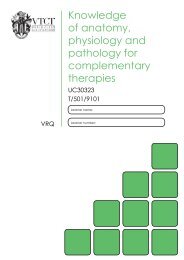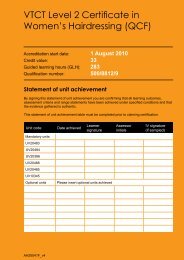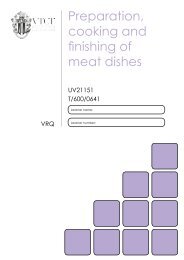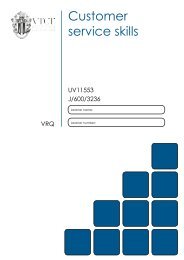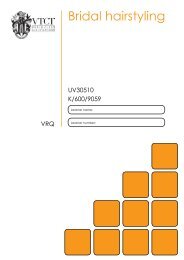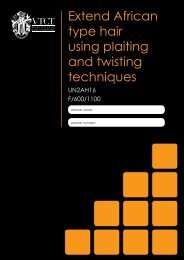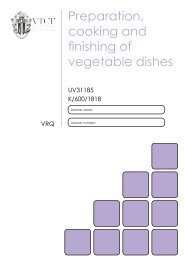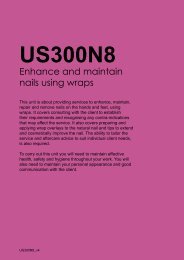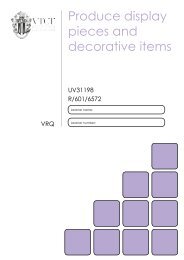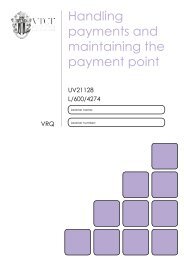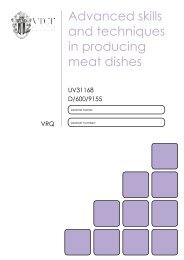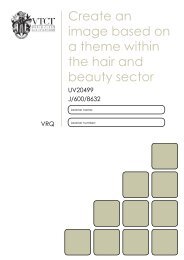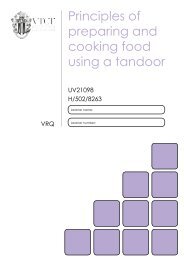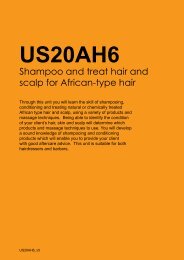Instruct and supervise gym- based exercise - Qualification Title - VTCT
Instruct and supervise gym- based exercise - Qualification Title - VTCT
Instruct and supervise gym- based exercise - Qualification Title - VTCT
Create successful ePaper yourself
Turn your PDF publications into a flip-book with our unique Google optimized e-Paper software.
<strong>Instruct</strong> <strong>and</strong><br />
<strong>supervise</strong> <strong>gym</strong>-<br />
<strong>based</strong> <strong>exercise</strong><br />
UF2D452<br />
L/601/7364<br />
Learner name:<br />
Learner number:
Statement of unit achievement<br />
<strong>VTCT</strong> is the specialist awarding body for the Hairdressing, Beauty Therapy,<br />
Complementary Therapy <strong>and</strong> Sport <strong>and</strong> Active Leisure sectors, with over 45<br />
years of experience.<br />
<strong>VTCT</strong> is an awarding body regulated by national organisations including<br />
Ofqual, SQA, DCELLS <strong>and</strong> CCEA.<br />
<strong>VTCT</strong> is a registered charity investing in education <strong>and</strong> skills but also giving to<br />
good causes in the area of facial disfigurement.<br />
By signing this statement of unit achievement you are confirming that all learning outcomes, assessment<br />
criteria <strong>and</strong> range statements have been achieved under specified conditions <strong>and</strong> that the evidence<br />
gathered is authentic.<br />
This statement of unit achievement table must be completed prior to claiming certification.<br />
Unit code Date achieved Learner signature<br />
Assessor tracking table<br />
Assessor name Assessor signature<br />
Assessor<br />
initials<br />
Assessors<br />
initials<br />
IV signature<br />
(if sampled)<br />
All assessors using this Record of Assessment book must complete this table. This is required for<br />
verification purposes.<br />
Assessor number<br />
(optional)
UF2D452<br />
<strong>Instruct</strong> <strong>and</strong> <strong>supervise</strong> <strong>gym</strong><strong>based</strong><br />
<strong>exercise</strong><br />
It is the aim of this unit to develop the knowledge,<br />
underst<strong>and</strong>ing <strong>and</strong> practical skills that you require to be<br />
able to instruct <strong>and</strong> <strong>supervise</strong> <strong>gym</strong>-<strong>based</strong> <strong>exercise</strong> to<br />
apparently healthy adults (individuals <strong>and</strong> groups). This<br />
may include young people aged 14-16 (provided they are in<br />
a larger adult group), older adults, antenatal <strong>and</strong> postnatal<br />
clients <strong>and</strong> disabled clients (provided the relevant contraindications<br />
<strong>and</strong> safety guidelines are observed).<br />
UF2D452_v5
NOS<br />
D452<br />
Level<br />
Credit value<br />
GLH<br />
2<br />
8<br />
43<br />
Observation(s)<br />
2<br />
External paper(s)<br />
0
<strong>Instruct</strong> <strong>and</strong> <strong>supervise</strong> <strong>gym</strong><strong>based</strong><br />
<strong>exercise</strong><br />
Learning outcomes<br />
On completion of this unit you will:<br />
1. Be able to prepare clients for <strong>gym</strong>-<strong>based</strong><br />
<strong>exercise</strong><br />
2. Be able to instruct <strong>gym</strong>-<strong>based</strong> <strong>exercise</strong><br />
3. Be able to observe <strong>and</strong> <strong>supervise</strong> <strong>gym</strong><strong>based</strong><br />
<strong>exercise</strong><br />
4. Be able to bring a <strong>gym</strong>-<strong>based</strong> <strong>exercise</strong><br />
session to an end<br />
5. Know how to prepare clients for <strong>gym</strong>-<strong>based</strong><br />
<strong>exercise</strong><br />
6. Know how to instruct <strong>gym</strong>-<strong>based</strong> <strong>exercise</strong><br />
7. Know how to observe <strong>and</strong> <strong>supervise</strong> <strong>gym</strong><strong>based</strong><br />
<strong>exercise</strong><br />
8. Know how to bring a <strong>gym</strong>-<strong>based</strong> <strong>exercise</strong><br />
session to an end<br />
Evidence requirements<br />
1. Evidence of real work activity<br />
You must produce evidence to meet all<br />
‘Observation’ outcomes <strong>and</strong> assessment<br />
criteria through your own work.<br />
2. Simulation<br />
Simulation is allowed for criteria 3i <strong>and</strong> 4h.<br />
3. Observation outcomes<br />
Competent performance of ‘Observation’<br />
outcomes must be demonstrated on at least<br />
two occasions. Assessor observations,<br />
witness testimony <strong>and</strong> products of work are<br />
likely to be the most appropriate sources of<br />
performance evidence. These observations<br />
should not be carried out on the same day.<br />
There should be sufficient time between<br />
assessments. Separating the assessment<br />
occasions by a period of at least one month<br />
is recommended.<br />
4. Range<br />
All ranges must be competently<br />
demonstrated.<br />
5. Knowledge outcomes<br />
There must be evidence that you possess<br />
all the knowledge <strong>and</strong> underst<strong>and</strong>ing listed<br />
in the ‘Knowledge’ section of this unit.<br />
In most cases this can be done by your<br />
assessor questioning you orally. However,<br />
other techniques, such as projects,<br />
assignments <strong>and</strong>/or reflective accounts may<br />
also be appropriate.<br />
6. Tutor/Assessor guidance<br />
You will be guided by your tutor/assessor<br />
on how to achieve learning outcomes <strong>and</strong><br />
ranges in this unit. All outcomes <strong>and</strong> ranges<br />
must be achieved.<br />
7. External paper<br />
There is no external paper requirement for<br />
this unit.<br />
UF2D452<br />
3
4<br />
Achieving observations<br />
<strong>and</strong> range<br />
Achieving observation outcomes<br />
Your assessor will observe your performance<br />
of practical tasks. The minimum number<br />
of observations required is indicated in the<br />
evidence requirements section of this unit.<br />
Criteria may not always naturally occur during<br />
a practical observation. In such instances you<br />
may be required to produce supplementary<br />
evidence, for example, questioning, projects or<br />
assignments may be used to demonstrate your<br />
competence in this area. Your assessor will<br />
document the criteria that have been achieved<br />
by supplementary evidence. Questioning to<br />
gather supplementary evidence can normally<br />
be carried out orally. However, oral questioning<br />
must be recorded by the assessor, in written<br />
form or by other appropriate means.<br />
Your assessor will sign off an outcome when all<br />
criteria have been competently achieved.<br />
Achieving range<br />
The range section indicates what must<br />
be covered. Ranges should be practically<br />
demonstrated as part of an observation.<br />
Your assessor will document the portfolio<br />
reference once a range has been competently<br />
achieved.<br />
UF2D452<br />
Guidance for tutors <strong>and</strong> assessors<br />
Tutors <strong>and</strong> assessors must refer to the<br />
following documents for guidance on<br />
assessment prior to delivering this unit. *These<br />
SkillsActive documents can be downloaded at<br />
www.SkillsActive.com:<br />
• QCF Evidence Requirements <strong>and</strong><br />
Assessment Guidance<br />
• Assessment Strategy for NVQs <strong>and</strong><br />
SVQs<br />
• Additional Requirements for<br />
<strong>Qualification</strong>s that use the title NVQ<br />
within the QCF<br />
*Learning outcomes <strong>and</strong> assessment criteria in<br />
these documents may be numbered differently<br />
to <strong>VTCT</strong> ROA books.<br />
Evidencing anatomy<br />
Learners must produce evidence to<br />
demonstrate knowledge of the major bones,<br />
joints <strong>and</strong> muscles as listed in unit D452 of the<br />
QCF Evidence Requirements <strong>and</strong> Assessment<br />
Guidance for <strong>Instruct</strong>ing Exercise <strong>and</strong> Fitness.
Outcome 1<br />
You can:<br />
a. Ensure the environment <strong>and</strong> equipment is<br />
prepared for the agreed <strong>exercise</strong>s<br />
b. Meet the clients punctually <strong>and</strong> help them<br />
feel welcome <strong>and</strong> at ease<br />
c. Collect any new information that is required<br />
d. Explain the agreed <strong>exercise</strong>s <strong>and</strong> their<br />
dem<strong>and</strong>s, including physical <strong>and</strong> technical<br />
dem<strong>and</strong>s<br />
e. Motivate the clients in a way that is<br />
appropriate to them<br />
f. Advise clients of the facility’s emergency<br />
procedures<br />
g. Confirm or revise what has been agreed<br />
with the clients<br />
*May be assessed by supplementary evidence.<br />
Observations<br />
Be able to prepare clients for <strong>gym</strong>-<strong>based</strong> <strong>exercise</strong><br />
Observation 1 2 Optional<br />
Criteria questioned orally<br />
Date achieved<br />
Portfolio reference<br />
Learner signature<br />
Assessor initials<br />
UF2D452<br />
5
6<br />
Outcome 2<br />
Be able to instruct <strong>gym</strong>-<strong>based</strong> <strong>exercise</strong><br />
You can:<br />
a. Use warm-up <strong>and</strong> cool down activities that<br />
are safe <strong>and</strong> effective for the clients<br />
b. Give explanations <strong>and</strong> demonstrations<br />
that are technically correct with safe <strong>and</strong><br />
effective alignment of <strong>exercise</strong> positions<br />
appropriate to clients’ needs <strong>and</strong> level of<br />
experience<br />
c. Check the clients’ underst<strong>and</strong>ing of<br />
instructions <strong>and</strong> give them the opportunity<br />
to ask questions<br />
d. Ensure the clients carry out <strong>exercise</strong>s in a<br />
safe <strong>and</strong> effective manner<br />
e. Give the clients the necessary information<br />
<strong>and</strong> motivate them to continue to carry out<br />
the <strong>exercise</strong>s without direct supervision<br />
f. Keep to the planned timings for the session<br />
g. Manage group behaviour as appropriate<br />
*May be assessed by supplementary evidence.<br />
Observation 1 2 Optional<br />
Criteria questioned orally<br />
Date achieved<br />
Portfolio reference<br />
Learner signature<br />
Assessor initials<br />
UF2D452
Outcome 3<br />
Be able to observe <strong>and</strong> <strong>supervise</strong> <strong>gym</strong>-<strong>based</strong> <strong>exercise</strong><br />
You can:<br />
a. Move around the area so that all clients can<br />
be observed <strong>and</strong> respond to their needs in<br />
a fair <strong>and</strong> equitable way<br />
b. Monitor <strong>exercise</strong> intensity using appropriate<br />
method/s<br />
c. Make sure all clients can take part in the<br />
<strong>exercise</strong>s<br />
d. Monitor the safety <strong>and</strong> effectiveness of the<br />
<strong>exercise</strong>s <strong>and</strong> adapt these accordingly with<br />
suitable progressions/regressions<br />
e. Provide feedback <strong>and</strong> instructing points<br />
which are timely, clear <strong>and</strong> motivational<br />
f. Encourage <strong>and</strong> support clients to take<br />
responsibility for their own fitness<br />
g. Review clients’ progress <strong>and</strong> offer fitness<br />
advice in response to clients’ changing<br />
needs<br />
h. Give clients the chance to ask questions<br />
<strong>and</strong> provide them with appropriate <strong>and</strong> clear<br />
information<br />
*May be assessed by supplementary evidence.<br />
Observation 1 2 Optional<br />
Criteria questioned orally<br />
Date achieved<br />
Portfolio reference<br />
Learner signature<br />
Assessor initials<br />
i. Refer clients to another professional<br />
when their needs go beyond own level of<br />
competence*<br />
UF2D452<br />
7
8<br />
Outcome 4<br />
Be able to bring a <strong>gym</strong>-<strong>based</strong> <strong>exercise</strong> session to an end<br />
You can:<br />
a. Allow sufficient time to end the session<br />
according to the clients’ level of experience<br />
b. End the session using cool down activities<br />
that are safe <strong>and</strong> effective for the clients<br />
c. Give the clients an accurate feedback<br />
summary on the session<br />
d. Give the clients the opportunity to:<br />
• reflect on the session<br />
• ask questions<br />
• provide feedback<br />
• identify their further needs<br />
e. Make sure the clients have the necessary<br />
information about future activities <strong>and</strong><br />
review procedures<br />
f. Follow the correct procedures for checking<br />
<strong>and</strong> dealing with any equipment used<br />
g. Leave the environment in a condition<br />
acceptable for future use<br />
h. Pass on suggestions for improving health<br />
<strong>and</strong> safety to a competent person or<br />
agency*<br />
*May be assessed by supplementary evidence.<br />
Observation 1 2 Optional<br />
Criteria questioned orally<br />
Date achieved<br />
Portfolio reference<br />
Learner signature<br />
Assessor initials<br />
UF2D452
You must practically demonstrate that you have:<br />
Range<br />
Used all communication styles Portfolio reference<br />
Motivational techniques appropriate to the individual<br />
Motivational techniques appropriate to the <strong>exercise</strong> format<br />
Prepared clients for <strong>exercise</strong>s that cover a minimum of 3<br />
components of fitness<br />
Cardiovascular fitness<br />
Muscular fitness<br />
Flexibility<br />
Motor skills<br />
Circuit formats<br />
Portfolio reference<br />
<strong>Instruct</strong>ed all client types Portfolio reference<br />
Individuals<br />
Groups<br />
<strong>Instruct</strong>ed all components of a <strong>gym</strong>-<strong>based</strong> session Portfolio reference<br />
Safe <strong>and</strong> effective warm-up<br />
Safe <strong>and</strong> effective cool down<br />
<strong>Instruct</strong>ed <strong>exercise</strong>s that cover a minimum of 3 components of<br />
fitness<br />
Cardiovascular fitness<br />
Muscular fitness<br />
Flexibility<br />
Motor skills<br />
Circuit formats<br />
Portfolio reference<br />
UF2D452 9
10<br />
You must practically demonstrate that you have:<br />
<strong>Instruct</strong>ed a minimum of 3 types of cardiovascular equipment Portfolio reference<br />
Upright cycle<br />
Recumbent cycle<br />
Treadmill<br />
Stepper<br />
Rowing machine<br />
Elliptical trainer<br />
Cross trainer<br />
<strong>Instruct</strong>ed a minimum of 3 body weight <strong>exercise</strong>s Portfolio reference<br />
Chins<br />
Press up<br />
Lunge<br />
Squat<br />
Abdominal curl/plank<br />
Back raise<br />
UF2D452
You must practically demonstrate that you have:<br />
<strong>Instruct</strong>ed a minimum of 4 fixed resistance machines Portfolio reference<br />
Seated chest press (neutral grip)<br />
Seated chest press (BB grip)<br />
Bench press<br />
Pec dec<br />
Seated row (low pulley)<br />
Seated row (neutral grip)<br />
Seated row (BB grip)<br />
Shoulder press<br />
Lat pull down (in front of chest)<br />
Assisted pull up<br />
Tricep pushdown (high pulley)<br />
Tricep press<br />
Bicep curl (low pulley)<br />
Seated bicep curl<br />
Leg press<br />
Total hip<br />
Seated knee extension<br />
Lying leg curl<br />
Seated abductor<br />
Seated adductor<br />
Seated leg curl<br />
Abdominal machine<br />
Lower back machine<br />
UF2D452 11
12<br />
You must practically demonstrate that you have:<br />
<strong>Instruct</strong>ed a minimum of 4 free weight <strong>exercise</strong>s Portfolio reference<br />
Front raise (DB)<br />
Single arm row<br />
Bent arm pullover (DB)<br />
Shoulder press (DB)<br />
Lateral raise (DB)<br />
Upright row (BB)<br />
Bench press<br />
Supine tricep press (BB)<br />
Prone flye (DB)<br />
Flyes (DB)<br />
Single arm tricep press (DB)<br />
Bicep curl (BB) (DB)<br />
Lunge (BB) or (DB) optional<br />
Deadlift (BB) (DB)<br />
Squat (BB) (DB)<br />
Spotting (must be covered in addition to the four chosen <strong>exercise</strong>s)<br />
Used all forms of instruction Portfolio reference<br />
Correct lifting <strong>and</strong> passing<br />
Lifting the barbell safely from the floor <strong>and</strong> spotting<br />
Accurate demonstrations of <strong>exercise</strong>s with particular attention to the<br />
speed of movement<br />
UF2D452
You must practically demonstrate that you have:<br />
Applied all methods of verbal communication Portfolio reference<br />
Voice projection<br />
Appropriate volume <strong>and</strong> pitch of voice<br />
Used all teaching methods Portfolio reference<br />
Observation of client from a variety of positions<br />
Control of client<br />
Correction of poor technique<br />
Regular teaching points<br />
UF2D452 13
14<br />
Developing knowledge<br />
Achieving knowledge outcomes<br />
You will be guided by your tutor <strong>and</strong> assessor<br />
on the evidence that needs to be produced.<br />
Your knowledge <strong>and</strong> underst<strong>and</strong>ing will be<br />
assessed using the assessment methods listed<br />
below:<br />
• Observed work<br />
• Witness statements<br />
• Audio-visual media<br />
• Evidence of prior learning or attainment<br />
• Written questions<br />
• Oral questions<br />
• Assignments<br />
• Case studies<br />
UF2D452<br />
Where possible your assessor will integrate<br />
knowledge outcomes into practical observations<br />
through oral questioning. Oral questioning must<br />
be recorded by your assessor, in written form or<br />
by other appropriate means.<br />
Some knowledge <strong>and</strong> underst<strong>and</strong>ing outcomes<br />
may require you to show that you know <strong>and</strong><br />
underst<strong>and</strong> how to do something. If you have<br />
practical evidence from your own work, then<br />
there is no requirement for you to be questioned<br />
again on the same topic.
Knowledge<br />
Outcome 5<br />
Know how to prepare clients for <strong>gym</strong>-<strong>based</strong> <strong>exercise</strong><br />
You can: Portfolio reference<br />
a. Explain the purpose <strong>and</strong> value of a warm-up<br />
b. Explain why clients need to underst<strong>and</strong> the purpose <strong>and</strong> value of a<br />
warm-up<br />
c. Describe safe <strong>and</strong> effective warm-up activities for <strong>gym</strong>-<strong>based</strong><br />
<strong>exercise</strong><br />
d. Explain the importance of fitness advice <strong>and</strong> how to offer it in <strong>gym</strong><strong>based</strong><br />
physical activity<br />
UF2D452 15
16<br />
Outcome 6<br />
Know how to instruct <strong>gym</strong>-<strong>based</strong> <strong>exercise</strong><br />
You can: Portfolio reference<br />
a. Describe the purpose of the <strong>exercise</strong>s included in the programme<br />
b. Describe a range of <strong>exercise</strong>s that are safe <strong>and</strong> appropriate for<br />
clients<br />
c. Describe the types of special requirements that clients may have<br />
d. Describe how to break <strong>exercise</strong>/movements down to their<br />
component parts<br />
e. Describe how to develop client’s co-ordination by building<br />
<strong>exercise</strong>s/movements up gradually<br />
f. Outline the information that must be given to other people who are<br />
involved in the client’s <strong>gym</strong>-<strong>based</strong> programme<br />
UF2D452
Outcome 7<br />
Know how to observe <strong>and</strong> <strong>supervise</strong> <strong>gym</strong>-<strong>based</strong> <strong>exercise</strong><br />
You can: Portfolio reference<br />
a. Outline the needs <strong>and</strong> potential of the clients<br />
b. Identify the types of hazards that may occur during a session <strong>and</strong><br />
how to manage these<br />
c. Outline the reporting procedures for health <strong>and</strong> safety<br />
d. Identify safe <strong>and</strong> effective alignment of <strong>exercise</strong> positions<br />
e. Identify a range of alternative <strong>exercise</strong>s for adaptation including<br />
any appropriate progressions <strong>and</strong> regressions<br />
f. Outline the importance/methods of voice projection to include the<br />
effective use of volume <strong>and</strong> pitch of voice<br />
UF2D452 17
18<br />
Outcome 8<br />
Know how to bring a <strong>gym</strong>-<strong>based</strong> <strong>exercise</strong> session to an end<br />
You can: Portfolio reference<br />
a. Explain the purpose <strong>and</strong> value of a cool down<br />
b. Explain why clients need to underst<strong>and</strong> purpose <strong>and</strong> value of a<br />
cool down<br />
c. Describe safe <strong>and</strong> effective cool down activities for <strong>gym</strong>-<strong>based</strong><br />
<strong>exercise</strong><br />
UF2D452



